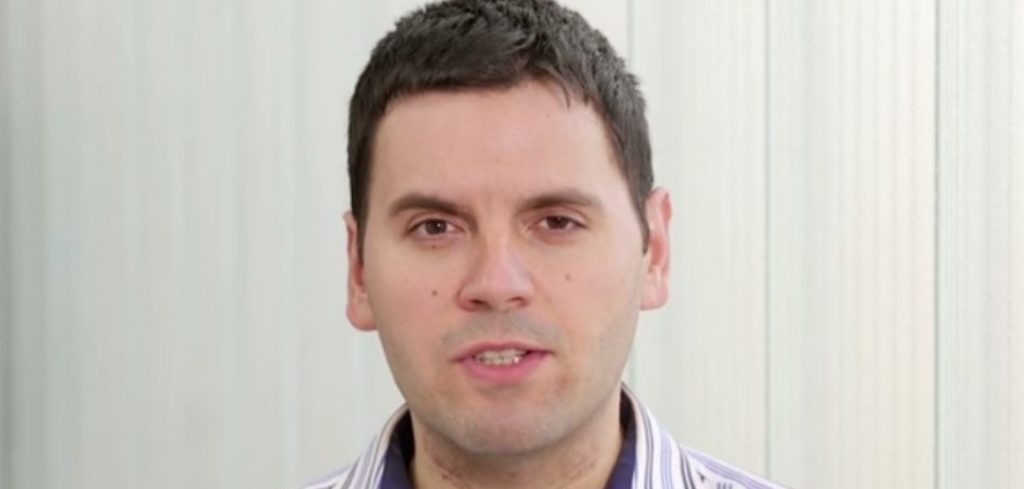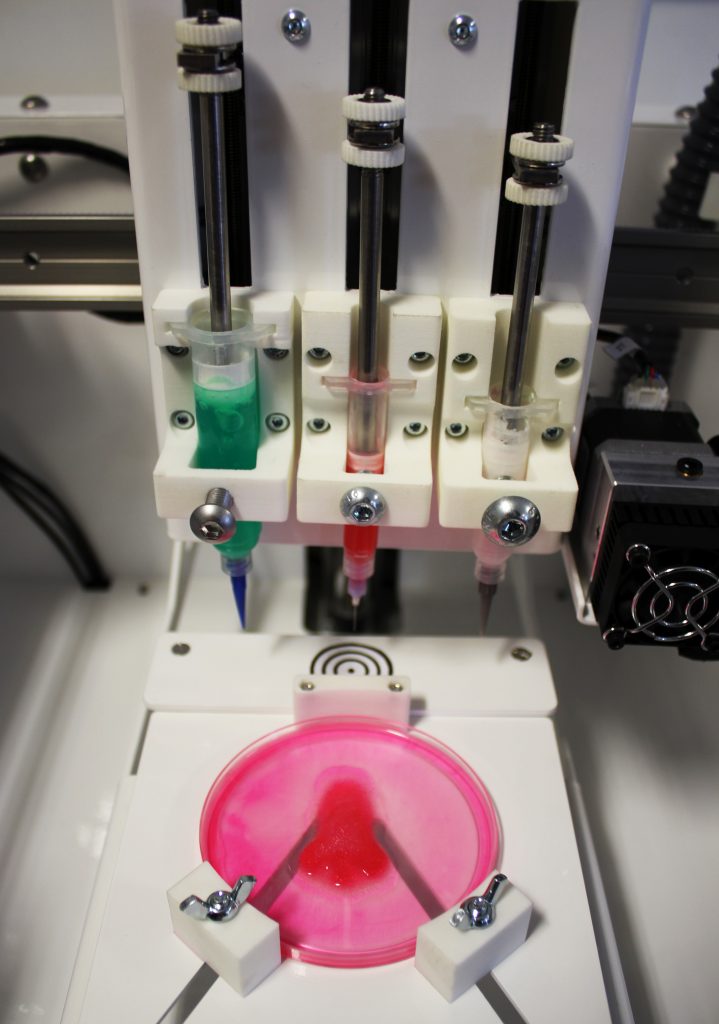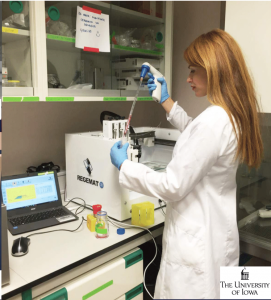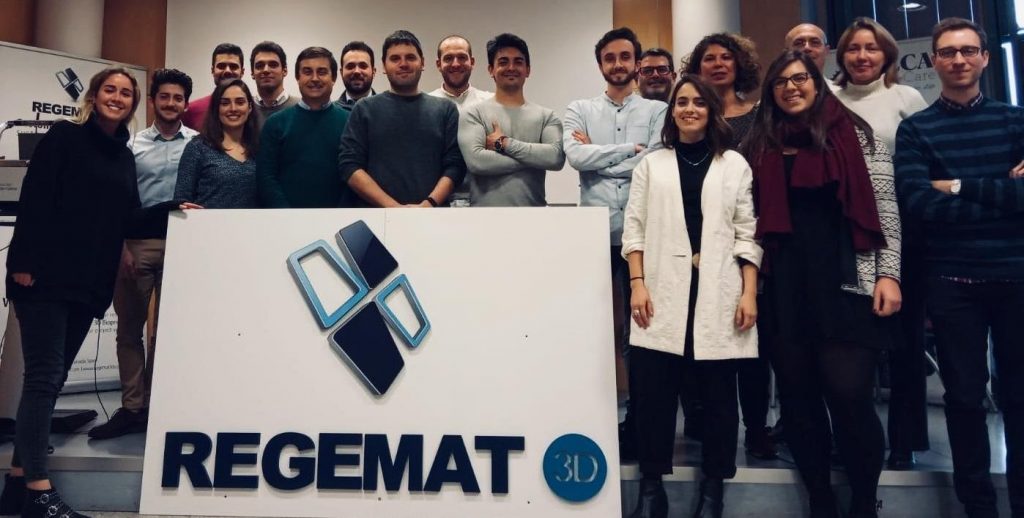Biogelx and Regemat 3D partner to provide complete 3D bioprinting solutions
3D Printing Industry News Sliced: AMT, BCN3D Technologies, ParaMatters, Prusa, NASA
REGEMAT 3D Will Start Selling Biomaterials
 One of the key players in the bioprinting field in Spain will be incorporating seven new biomaterials. In the coming months, REGEMAT 3D will launch a catalog of biomaterials that customers can buy and use along with their bioprinting systems. According to company officials, in recent years, advances in 3D bioprinting systems have become very important, as well as new biomaterials for regenerative medicine. The performance of the research groups with which they collaborate has produced results that were likely unheard of years ago. Still, they consider that these innovations in bioprinting systems must be accompanied by a progressive definition and characterization of the biomaterials being used. This year, one of REGEMAT 3D’s objective is to advance biomaterials for further research in the different applications derived from the 3D bioprinting sector, which is growing every year.
One of the key players in the bioprinting field in Spain will be incorporating seven new biomaterials. In the coming months, REGEMAT 3D will launch a catalog of biomaterials that customers can buy and use along with their bioprinting systems. According to company officials, in recent years, advances in 3D bioprinting systems have become very important, as well as new biomaterials for regenerative medicine. The performance of the research groups with which they collaborate has produced results that were likely unheard of years ago. Still, they consider that these innovations in bioprinting systems must be accompanied by a progressive definition and characterization of the biomaterials being used. This year, one of REGEMAT 3D’s objective is to advance biomaterials for further research in the different applications derived from the 3D bioprinting sector, which is growing every year.
Each specific application requires different solutions and appropriate biomaterials to optimize processes. For instance, it is easy to understand that to regenerate skin components, hydrogels, cells and growth factors are different from those needed to regenerate muscle tissue, bone or cornea. So, it is essential to offer researchers and scientists different biomaterials to aid their work. REGEMAT is focusing on seven: thermoplastics, collagens, alginates, agaroses, gelatin methacryloyl (GelMA), nanocellulose, and different types of cell media compatible with the cells used. All of the biomaterials should be easy to print, handle and will allow researchers to tackle some of the challenges they face while working.
The new biomaterials for 3D bioprinting will be available on the company’s web page (which they will relaunch shortly), as well as through their offices. REGEMAT 3D has agreements with several national and international partners for the manufacture of these products. The first ones to be sold commercially will be nanocellulose, collagen, and alginate.
The Granada, Spain-based biotech company has sold its machines to users in more than 25 countries. For years, the company has been working with research groups at the University of Granada in advanced therapies, participated in a joint project for the development of new therapies for cartilage regeneration, and has collaborated with the University Hospital of La Paz, where REGEMAT 3D’s founder coordinates the 3D Tissue Engineering and Printing Platform (PITI3D), which provides ingredients and processes to generate functional tissues. Since its origin, the startup has been focusing on regenerative medicine, developing custom hardware and software required and demanded by some of the major hospitals and research universities in the region. They develop their own bioprinting systems – the BIO V1 machines – and customize them for their users’ applications according to the requirements of each investigation.
Last January, a group of researchers led by the University of Granada and REGEMAT 3D, published an academic article on the development of a volume-by-volume 3D biofabrication process that divides the printed part into different volumes and injects the cells after each volume has been printed, once the temperature of the printed thermoplastic fibers has decreased. This helps overcome problems that arise when working in 3D bioprinting with thermoplastics at high temperatures: one of the biomaterials they will soon begin commercializing, with which the company is very familiar and has worked with for a long time.
To continue developing new biomaterials and launching new products, the Spanish company, led by founder and CEO José Manuel Baena, has managed to raise 320,000 Euros in the midst of the latest financing round. REGEMAT 3D, along with its sister company Breca, are not only launching the new series of biomaterials, but they are also expanding their presence to Brazil, where the company has already started to market its products, and China, where they closed an agreement with Chinese distributor ApgBio, based in Shanghai, that’s responsible for introducing bioprinting equipment in the country for the regeneration of organs or tissues. Companies like REGEMAT 3D are gearing up to mass produce biomaterials, providing researchers with more options when it comes to bioprinting for regenerative medicine and advanced therapies, usually keeping in mind how patients bodies will react to the new materials, and whether they will be compatible. Spain, like many other European countries, is quickly catching up to the world of bioprinting, which today is led by US-based companies but shows promise in many developed countries.
[Images: REGEMAT 3D]
The post REGEMAT 3D Will Start Selling Biomaterials appeared first on 3DPrint.com | The Voice of 3D Printing / Additive Manufacturing.
Interview with Jose Manuel Baena of Regemat 3D and Breca Health Care
Jose Manuel is a healthcare entrepreneur and CEO, bringing new technologies from lab to bed to improve people’s quality of life. He is working in more than 20 countries. He is the Founder and CEO of BRECA Health Care and REGEMAT 3D. He is looking to pioneer the revolution of 3D printing and bioprinting in healthcare. He was born in Valencia in October 1983. He studied engineering in Valencia, Spain, Braunschweig, Germany, and Oxford, UK, where he got his MSc in Motorsport engineering supported by the grant program of F1 world champion Fernando Alonso. He has also studied biomedical engineering in Buenos Aires, Argentina, and he just finished his PhD in Biomedicine in Biomedicine at the University of Granada, he is now a doctor.
What inspired you to do a lot within the healthcare industry?
While working at the F1 team, I decided to focus my career on the intersection between engineering and medical sciences. I could have worked on designing cars but medical devices were more motivational and challenging for me.
Ten years ago I started researching and designing custom made implants and thought that, 3D printing could be used for doing amazing customized implants. In 2010, I started working on the BRECA Health Care Business plan. The company was founded in early 2011, and at that time 3D printing was not that popular. Various people told me that I was never going to bring it to the clinical world. We now have dozens of successful clinical cases around the world.
Back in 2011, a researcher from the University of Granada asked him to develop a system in which we could print cells rather than Titanium, to solve the problems of apoptosis and the differentiation I had been working in 2D cultures. At that time the number of available solutions were 0. This is how I got inside this amazing industry. Some years later I started REGEMAT 3D to bring to society the results of our development from 2011. Now after few years we have a presence in more than 25 countries.
Early in 2018 and thinking on his future research after the PhD, I decided to get involved in a research group with a clinical focus to bring new treatments to patients that is how I started at the PITI3D platform as a Scientific coordinator and also a main figure in the start up of the platform.
What are interesting things to pay attention to within the healthcare sector for bioprinting? How does 3D Printing revolutionize your day to day work?
We believe that bioprinting is in a kind of hype period. Biological sciences can benefit a lot from these ranges of different technologies, but it is not true that we are going to be printing functional organs in the short term. You can say that to do an IPO and get funding but after some years when results don’t ́t come as expected, you are going to fall. I saw it many years ago with 3D printing in medical devices, then after that the curve of expectations decreases and a lot of detractors arise. Just when you show the results it is when the technology starts being used and find a place in the market.
Also it is important to make clear that what we print with a bioprinter is not a tissue; it is a matrix, a scaffold, with cells in 3D, that as we showed many years ago behave in a similar way to the cells in vivo, but still a procedure that needs to have a functional tissue to be implanted.
Mechanical stress after printing and other ingredients play an important role in the outcomes of the tissue. We think of bioprinting as an amazing range of technologies to achieve our aims as researchers that want to mimic living structures but there still are a lot of things to do to cover all tissues. That is why we in REGEMAT 3D offer not just a bioprinting system but a customized one for every specific application. In the short term we see a lot of opportunities in the combination of 3D printed custom made synthetic medical devices and bioprinted structures to regenerate an injury.
What are some projects that Regemat has been working on recently?
We have been working on a lab on a chip Kit for antitumoral treatments. This includes Cornea Regeneration. We are also testing a new biomaterial based on the skin of a butterfly as well.
What are some projects that BRECA HealthCare has been working on recently?
We have worked on surgical guides, prosthesis and implants for Maxillofacial, thoracic box, osteosarcoma, and knee-related projects.
Are there ways to fuse these two industries as it seems that the work you do must have interconnection in order for one to transition between both?
Thanks to our previous experience with Breca Health Care, we offer some advantages to our collaborators such as:
- Benefiting from all the results and new components developed by our bioprinting community
- We can customize the solution and the specifications for your research. This will make it unique.
- Funding opportunities
- Royalties for co-development
- As implanting medical devices experts, we will help you to bring your results from lab to bed
- Advertising in media
- Discounts in the modifications and ad hoc projects
- Discounts in the new versions and components
- Pre-clinical and clinical projects in cooperation with PITI3D
What are some concerns you have over the healthcare industry as a whole in terms of innovation? What are some benefits that the industry has as well?
The regulatory sector is important. We are now trying different applications with this technology at a pre-clinical phase, but we need to work on what will happen once we can go through the clinical applications with real patients. The benefit of this situation is the fact that we are helping to develop the regulation and we are completely involved in this sandbox.
Lastly, what is the future of bioprinting? What fields of study will be crucial for its future development?
Our approach is to create a tissue is quite unique as we are always thinking on the clinical application and how custom made surgical implants can promote the formation of a living tissue and the regeneration of a defect. For the creation of a living tissue it is crucial the bioprinting process and the ingredients selected to achieve the objective to create a functional specific tissue the scaffold, the cells, the bioinks and the other ingredients to be printed that will promote the formation of the right tissue. But also the maturation procedure applied to the 3D cell laden constructs, that is even more important. If we think about bioprinting as a technology to recreate all the structure in the same form as shown in a living tissue, we are going to fail. We have to think on bioprinting as a way of creating cell laden 3D constructs as a precursor of a functional tissue. The maturation and tissue formation process, in vivo or bioreactors mimicking the implantation body, will be as important or even more than the bioprinting one. Considering the strategies of both parts will be crucial to obtain the desired functional knee cartilage tissue. They are pioneering both fields!
Spanish Company BRECA Health Care is at the Forefront of Medical Devices & Bioprinting
 In 2018 Spain’s health care system ranked third in the world, behind Hong Kong and Singapore, and first in Europe according to a Bloomberg study, so it’s no wonder that research and development of bioprinting technologies are heavily pushing to make the country a haven for its patients. In 2011, industrial engineer José Manuel Baena funded BRECA, a Granada-based healthcare company with its sights set on helping medicine solve some of the most complex pathologies out there. BRECA is a pioneer in Europe, specializing in the design, manufacture and marketing of customized implants. It is also one of the first companies in the world to manufacture a 3D printed implant using a combination of 3D printed made-to-measure synthetic medical devices and bioprinted structures to regenerate a lesion. It’s all about solving the greatest number of pathologies for Baena.
In 2018 Spain’s health care system ranked third in the world, behind Hong Kong and Singapore, and first in Europe according to a Bloomberg study, so it’s no wonder that research and development of bioprinting technologies are heavily pushing to make the country a haven for its patients. In 2011, industrial engineer José Manuel Baena funded BRECA, a Granada-based healthcare company with its sights set on helping medicine solve some of the most complex pathologies out there. BRECA is a pioneer in Europe, specializing in the design, manufacture and marketing of customized implants. It is also one of the first companies in the world to manufacture a 3D printed implant using a combination of 3D printed made-to-measure synthetic medical devices and bioprinted structures to regenerate a lesion. It’s all about solving the greatest number of pathologies for Baena.
“There are many diseases in the world and most of us are going to be users of these medical solutions some day, so investing time in creating the necessary equipment to help the medical community is essential,” Baena told 3DPrint.com during an interview.
The founder of BRECA Health Care is also founder and CEO of REGEMAT 3D, a startup focusing on regenerative medicine, developing custom hardware and software required and demanded by some of the mayor hospitals and research universities in the region, as well as creating bioinks for bioprinting -from commercial to bioinks developed with university labs made of cellulose, colagen paste and with thermoplastic properties ideal for cellular therapy. They develop their own bioprinting systems, the BIO V1 machines, and customize them for their users’ applications according to the requirements of each investigation. It was back in 2011 when Baena met Juan Antonio Marchal, a professor at the Biomedical Research Centre (CIBM) of the Universidad de Granada, in Spain, working with cells and looking to make scaffolds and 3D matrices, that his interest in regenerative medicine peaked, so he began creating technology and synthetic materials to make cells that would help doctors repair and regenerate injuries.
“I see an exciting future ahead, with 3D printing offering many opportunities and applications in regenerative and therapy medicine. The next stage of bioprinting is to combine several tissues and build in vitro organs, but that could take decades. To get to a point where we can create functional complex solid organs, we need more developments, research, more people interested in using this technology, which is a fascinating tool for in-depth knowledge on the future creation of organs. It is also important to understand how bioreactors and decellularization will help us to develop functional tissues and organs. Which is why we have groups of researchers currently working on these applications, both in the short-term and looking way ahead into the future,” suggested Baena, one of the many enthusiasts who are trying to bridge 3D printing technology with medicine.
There are a lot of opportunities right now for companies like BRECA, like the combination of 3D printed custom made synthetic medical devices and bioprinted structures to regenerate an injury. According to Baena, in the past, if you wanted to do a reconstruction using biomaterials that biodegrade, you were restricted by the geometry and performance of sized medical devices. But now with 3D printing they offer customized solutions even using autologous cells of the patient to enhance the regeneration. REGEMAT 3D’s bioprinting platform is ideal for developing this type of customized options and along with BRECA they are very successful in bringing 3D printed implants and prosthesis to the clinical application with optimum results.
BRECA was one of the pioneer companies in bioprinting, introducing the first bioprinter in the country. Today, they are the only Spanish company that designs and manufactures them on site. They also create bioreactors and in 2018 attempted to engineer cartilage tissue, one of the most promising treatments for articular cartilage defects, thanks to a bioreactor designed to implement a non-invasive real-time monitoring of the neo-cartilage tissue formation processes through ultrasonic signal analysis. Polylactic acid (PLA) scaffolds were printed and seeded with human chondrocytes and then, they were cultured in an ultrasound-integrated bioreactor. The team used a bioreactor system to validate ultrasound data against proliferation, gene expression and quantitative biochemistry of in vitro 3D chondrocytes.
With a total of 200 clinical cases all over the world, BRECA is helping doctors transition to a more customized solution that will improve patients’ lives. Through more personalized treatments, reducing complex surgical times and costs, the company is using 3D printing technologies for reconstruction of injuries in cranioplasty, maxillofacial, bone and cartilage, pediatric and thoracic surgery, neurosurgery, as well as other reconstructions with tailor-made surgical guides. Various reconstruction surgeries were performed at the University Hospital of La Paz, one of BRECA’s research partners, and where Ramón Cantero and Baena coordinate the 3D Tissue Engineering and Printing Platform (PITI3D), which provides ingredients and processes to generate functional tissues.
“Last year we started working with PITI 3D, a fantastic 3D printing platform for tissue engineering at one of the most innovative hospitals in Spain. We offer solutions for patients, medical doctors and scientists in regenerative medicine applications. Our current projects include skin regeneration, specifically for a pediatric pathology known as butterfly skin (a genetic mutation that results in skin blistering); Kit Lab on a chip for antitumor treatments, and manufacturing custom-made medical devices for complex surgeries at the University Hospital of La Paz (which we do through BRECA),” suggested Baena, who recently graduated with his PhD in Biomedicine.
Among the top 10 bioprinting companies in the world, BRECA has over 50 active projects in 25 countries, including the University of Sydney, Australia, the University of Iowa, in the U.S., the Paper and Fibre Research Institute of Sweden, Virgen del Rocio Hospital in Seville and Colombia´s National Institute of Rehabilitation. They have participated in many neurosurgery processes by developing the made-to-order medical devices for cranioplasty in patients with injuries or cranial defects, as well as jaw reconstructions and other types of bone prosthesis. The custom contoured grafts are made from materials such as titanium or synthetic bone substitutes.
“Many of the other bioprinting companies are selling mass-produced 3D printers but we chose to offer a one-of-a-kind machine for the researcher who wants to create unique bioprints, and this is working quite well for us, because we don’t just want to have our printers in every bioprinting lab, instead we like to be involved in the research being done, get to know the projects and help in any way we can. The BRECA-REGEMAT model is strongly invetsting on the future of clinical applications of additive manufacturing. There has been a continuous growth in bioprinting advances in the last thre years, but I consider that the next five years will see a strong increase in bioprinting discoveries,” says Baena.
With so many applications for bioprinting in the horizon, Baena believes that once we can engineer any human fully functional tissue, the next frontier will lie in uploading our memories, knowledge and consciousness for storage and to eventually regenerate encephalitic mass. He explains that we have the regeneration part down, but we need technologies and processes that will allow us to copy the existing information in the brain so that we can regenerate it too. “Like a backup of our brain”, he calls it. And although the scientist and engineer know that the idea is far fetched and could take years before it actually happens, he believes that “continuous investigation is the key to making the impossible possible.” After all, regenerating tissues was something that sounded quite futuristic some 50 years ago.
The Spanish company believes in the advantages and potential of technology, as well as in its innumerable applications, but there is still a lot of investigation on the way and decades before some of the more daring ventures, like creating fully functional organs, become realities. According to Baena, Spanish legislation is not an impediment for using the 3D printing machines, but yes when it comes to the clinical phase, so it might be a few years before some of the research gets to patient clinical trials and lawmakers catch up to some of the technological advances tacking place today.











